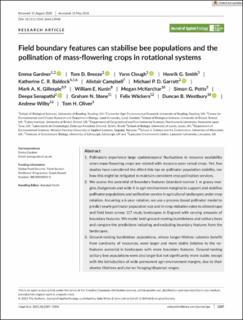| dc.contributor.author | Gardner, Emma | |
| dc.contributor.author | Breeze, Tom D. | |
| dc.contributor.author | Clough, Yann | |
| dc.contributor.author | Smith, Henrik G. | |
| dc.contributor.author | Baldock, Katherine C. R. | |
| dc.contributor.author | Campbell, Alistair | |
| dc.contributor.author | Garratt, Michael P. D. | |
| dc.contributor.author | Gillespie, Mark Andrew Kusk | |
| dc.contributor.author | Kunin, William E. | |
| dc.contributor.author | McKerchar, Megan | |
| dc.contributor.author | Potts, Simon G. | |
| dc.contributor.author | Senapathi, Deepa | |
| dc.contributor.author | Stone, Graham N. | |
| dc.contributor.author | Wäckers, Felix | |
| dc.contributor.author | Westbury, Duncan B. | |
| dc.contributor.author | Wilby, Andrew | |
| dc.contributor.author | Oliver, Tom H. | |
| dc.date.accessioned | 2022-03-02T14:05:23Z | |
| dc.date.available | 2022-03-02T14:05:23Z | |
| dc.date.created | 2022-01-27T14:57:13Z | |
| dc.date.issued | 2021 | |
| dc.identifier.citation | Gardner, E., Breeze, T. D., Clough, Y., Smith, H. G., Baldock, K. C. R., Campbell, A., . . . Oliver, T. H. (2021). Field boundary features can stabilise bee populations and the pollination of mass‐flowering crops in rotational systems. Journal of Applied Ecology, 58(10), 2287-2304. | en_US |
| dc.identifier.issn | 0021-8901 | |
| dc.identifier.uri | https://hdl.handle.net/11250/2982576 | |
| dc.description.abstract | Pollinators experience large spatiotemporal fluctuations in resource availability when mass-flowering crops are rotated with resource-poor cereal crops. Yet, few studies have considered the effect this has on pollinator population stability, nor how this might be mitigated to maintain consistent crop pollination services.
We assess the potential of boundary features (standard narrow 1 m grassy margins, hedgerows and wide 4 m agri-environment margins) to support and stabilise pollinator populations and pollination service in agricultural landscapes under crop rotation. Assuming a 6-year rotation, we use a process-based pollinator model to predict yearly pollinator population size and in-crop visitation rates to oilseed rape and field bean across 117 study landscapes in England with varying amounts of boundary features. We model both ground-nesting bumblebees and solitary bees and compare the predictions including and excluding boundary features from the landscapes.
Ground-nesting bumblebee populations, whose longer-lifetime colonies benefit from continuity of resources, were larger and more stable (relative to the no-features scenario) in landscapes with more boundary features. Ground-nesting solitary bee populations were also larger but not significantly more stable, except with the introduction of wide permanent agri-environment margins, due to their shorter lifetimes and shorter foraging/dispersal ranges.
Crop visitation by ground-nesting bumblebees was greater and more stable in landscapes with more boundary features, partly due to increased colony growth prior to crop flowering. Time averaged crop visitation by ground-nesting solitary bees was slightly lower, due to females dividing their foraging time between boundary features and the crop. However, despite this, the minimum pollination service delivered was higher, due to the more stable delivery.
Synthesis and applications. Field boundary features have an important role in stabilising pollinator populations and pollination service in rotational systems, although maintenance of larger semi-natural habitat patches may be more effective for stabilising less mobile solitary bee populations. We recommend using combinations of boundary features, accounting for pollinator range when spacing features/rotating crops, and synchronising boundary feature management with crop rotation to maximise their stabilising benefits. | en_US |
| dc.language.iso | eng | en_US |
| dc.publisher | Wiley | en_US |
| dc.rights | Navngivelse 4.0 Internasjonal | * |
| dc.rights.uri | http://creativecommons.org/licenses/by/4.0/deed.no | * |
| dc.title | Field boundary features can stabilise bee populations and the pollination of mass-flowering crops in rotational systems | en_US |
| dc.type | Peer reviewed | en_US |
| dc.type | Journal article | en_US |
| dc.description.version | publishedVersion | en_US |
| dc.rights.holder | © 2021 The Authors. | en_US |
| dc.source.pagenumber | 2287-2304 | en_US |
| dc.source.volume | 58 | en_US |
| dc.source.journal | Journal of Applied Ecology | en_US |
| dc.source.issue | 10 | en_US |
| dc.identifier.doi | 10.1111/1365-2664.13948 | |
| dc.identifier.cristin | 1991519 | |
| cristin.ispublished | true | |
| cristin.fulltext | original | |
| cristin.qualitycode | 2 | |

